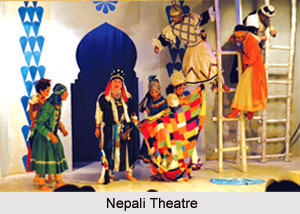 Nepali theatre is pretty common is parts of India where the language is spoken. The Nepali language exists in some parts of India, mainly northern West Bengal and Sikkim.
The Kirata period that has records of Nepali history produced Mundhum, which is the Veda of Tibeto-Burman Kiratas that contains dramatic elements. But it makes little or no mention of plays or actual stage. However, some scholars are of the opinion that Harisiddhi play, which is still popular in present days, had its inception during this period. The Licchavi period (third-ninth centuries) was popular for Sanskrit Theatre produced in specially made pavilions called "mandapikas" adjoining the temples. Mythological plays performed, especially that of Ramayana, was extremely popular.
Nepali theatre is pretty common is parts of India where the language is spoken. The Nepali language exists in some parts of India, mainly northern West Bengal and Sikkim.
The Kirata period that has records of Nepali history produced Mundhum, which is the Veda of Tibeto-Burman Kiratas that contains dramatic elements. But it makes little or no mention of plays or actual stage. However, some scholars are of the opinion that Harisiddhi play, which is still popular in present days, had its inception during this period. The Licchavi period (third-ninth centuries) was popular for Sanskrit Theatre produced in specially made pavilions called "mandapikas" adjoining the temples. Mythological plays performed, especially that of Ramayana, was extremely popular.
The period that witnessed significant progress and development on Nepali stagecraft or scenography was the Malla period. Performances were conducted outside the premises of the temple, into the open - in a public place, on dabalis, or raised stone platforms. Invariably they were in the form of dance or musical dramas. In most cases the Malla plays were in Maithili language and Newari. Kati Pyakham ("Kartik ritual drama"), which ran for the entire month of Kartik (October-November), came in fashion.
During the Shah period (1767 onwards) modern proscenium made its appearance which was followed by Rana period (1846 onwards) that abounded in entertaining Urdu theatre and Hindi theatre. Nonetheless, the Dabali performances continued to be famous and creative. In the Tibeto-Burman language of Newari, the Jyapu Natak of peasant Jyapus, developed as a genre that was greatly accepted and acclaimed. Dhintamai was yet another celebrated variant of Jyapu popular theatre. Attempts have been made to present modern Nepali plays in the traditional folk Jyapu styles.
 Ever since Shaktivallabh Aryal`s version of Hasyakadamba (`Comic kadamba Tree`, 1798), Sanskrit plays were translated into Nepali language. But plays written in Nepali were staged in North Bengal in parts of Darjeeling in the year 1909 by Dhanbir Mukhia and his pioneering Gorkha National Theatrical Party: Pahalman Singh Swar`s Atalbahadur, published from Varanasi in 1906. Potential supporters and followers were the Himalayan and Children`s Amusement Association, a club popular for the reformist actor-dramatist Bhaiya Singh Gazmer (1898-1968), and the Gorkha Dukha Niwarak Sammelan, a social organization. Balkrishna Sama (1902-81) wrote the first modern Nepali play, the social tragedy Mutuko byatha (`Heart`s Pangs`), in 1926. Regularly successful author penned as many as eighteen full-length and fourteen one-act plays. Prahlad (1929) is regarded as his masterpiece. A verse allegory, it reflects Gandhian principles and predicts Hitlerian methods. Gopalprasad Rimal and the Malla brothers, Govind and Vijay, ushered in realism, both social and psychological.
Ever since Shaktivallabh Aryal`s version of Hasyakadamba (`Comic kadamba Tree`, 1798), Sanskrit plays were translated into Nepali language. But plays written in Nepali were staged in North Bengal in parts of Darjeeling in the year 1909 by Dhanbir Mukhia and his pioneering Gorkha National Theatrical Party: Pahalman Singh Swar`s Atalbahadur, published from Varanasi in 1906. Potential supporters and followers were the Himalayan and Children`s Amusement Association, a club popular for the reformist actor-dramatist Bhaiya Singh Gazmer (1898-1968), and the Gorkha Dukha Niwarak Sammelan, a social organization. Balkrishna Sama (1902-81) wrote the first modern Nepali play, the social tragedy Mutuko byatha (`Heart`s Pangs`), in 1926. Regularly successful author penned as many as eighteen full-length and fourteen one-act plays. Prahlad (1929) is regarded as his masterpiece. A verse allegory, it reflects Gandhian principles and predicts Hitlerian methods. Gopalprasad Rimal and the Malla brothers, Govind and Vijay, ushered in realism, both social and psychological.
Modern day and contemporary Nepali dramatists, especially those who are highly celebrated, transcend matter of fact realism. Works of these pioneering people invoke awareness and thoughts in suitably new and improved forms to embody the contents. Mohanraj Sharma`s Baikuntha Express (`Paradise Express`, 1985) brought forth the risky journey the universe has to embark on, driven by compelling desire to reach a land of pleasure and affluence. Sharad Chetri in Khub nachyo kathaputali ("Merrily Danced the Puppet"), talks of the nothingness of all existence, which lies at the centre of all reality. In his book Ashvatthama hatshatah (`Ashvatthama Is Dead`, 1994), Avinash Shrestha, clearly asserts that Yudhisthira`s damnable half-truth uttered in the battle of Kurukshetra has propagated, and half-truths have come to rule the earth, mankind living an accursed life. In Malamiharu (`Funereal Procession`, 1995), its author - Saroo Bhakta, vividly portrays all people as helpers at the funeral of humanism. Nanda Hangkhim in his Abhishek ("Consecration", 1995) picks up the thread of Oedipus tragedy to ask: could not the child born of incestuous and sinful wedlock be consecrated and crowned?
The test of existential realism of the modern world to accept hard reality lay therein. Surely, existence is greater and more stubborn than of course considerations of morality. These Eve writers actually stand for modernism in Nepali theatre.




















